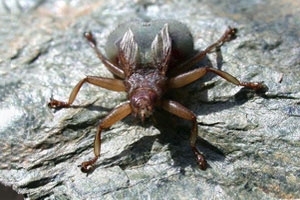Swift louse-fly (Crataerina pallida)
 On warm summer evenings, the inhabitants of most villages and towns across the country can witness a superb, scorchingly fast aerial display, as the local swifts gather together to race and scream through the skies, like a bunch of out of control teenagers on noisy motorbikes.
On warm summer evenings, the inhabitants of most villages and towns across the country can witness a superb, scorchingly fast aerial display, as the local swifts gather together to race and scream through the skies, like a bunch of out of control teenagers on noisy motorbikes.
As I stand and watch these masters of the air, who often reach speeds in excess of 70+ mph, I frequently think of the little jockeys riding on their backs, clinging on for dear life amongst the feathers.
These hitchhikers are the host specific parasitic flat-fly called Crataerina pallida that is a blood-feeding louse-fly. It helps to have a flattened triangular body when flying at 70+ mph!
This particular louse is only found on swifts and is about the size of your small finger nail, so actually surprisingly big in comparison to the host. In fact it is about a twentieth the size of the swift and someone has worked out that it would be the equivalent of having a good sized shore crab on you!! This sounds bad enough, but wait until I tell you that up to 20 have been found on one bird!
The louse feeds on the blood of both swift nestlings and adults, sucking about 25mg of blood every five days. Many think that a heavy infestation of these flies can be debilitating to the swift and contribute to an overall weakening of the bird, however research has thus far found no evidence that the swifts are adversely affected. It is of course in the interest of the parasite not to be too demanding of its host, as their continued survival ensures that more blood will be available into the future.
In the late summer, the louse flies produce eggs and larvae in and around the nest site, which quickly pupate and remain throughout the winter in this state. When the adult swifts return the following spring and lay a new clutch of eggs, the warmth of the incubating bird encourages the flies to emerge and start to feed on both the nestlings and parents birds, starting the cycle all over again. Research has shown that basically 100% of nest sites are infected to some degree and that populations of louse on adult swifts show a strong bias towards female birds.
We have much more to learn about this strange relationship between louse and bird. Does, for instance, the louse benefit the swift in any way – or is it all take, take?
So, when you next take and evening stroll and watch the scythe winged gang of screaming jet fighters zooming past overhead – remember that they are not on their own up there!
Peter Thompson
Advisory

Download Peter Thompson's essential 26-page book, featuring beautiful photography and detailed profiles of Britain's wildlife
Download FREE >